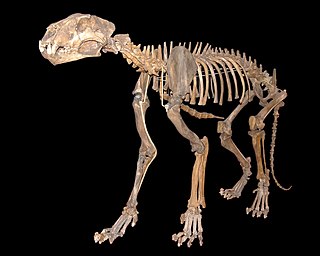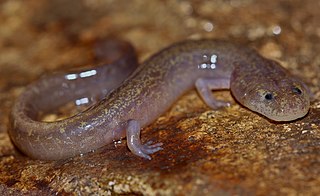The northern cavefish or northern blindfish is found in caves through Kentucky and southern Indiana. The International Union for Conservation of Nature lists the species as near threatened.
Panthera is a genus within the family Felidae, and one of two extant genera in the subfamily Pantherinae. It contains the largest living members of the cat family. There are five living species: the jaguar, leopard, lion, snow leopard and tiger, as well as a number of extinct species.

Panthera spelaea, commonly known as the cave lion is an extinct Panthera species native to Eurasia and northwest North America during the Pleistocene epoch. Genetic analysis of ancient DNA has revealed that while closely related, it was a distinct species genetically isolated from the modern lion, with the genetic divergence between the two species estimated at around 500,000 years ago. The earliest fossils of the P. spelaea lineage in Eurasia date to around 700,000 years ago. It is closely related and probably ancestral to the American lion. The species ranged from Western Europe to eastern Beringia in North America, and was a prominent member of the mammoth steppe fauna, and an important apex predator across its range. It became extinct about 13,000 years ago. It closely resembled living lions with a coat of yellowish-grey fur, though unlike living lions males appear to have lacked manes.

The American lion is an extinct pantherine cat native to North America during the Late Pleistocene from around 130,000 to 12,800 years ago. Genetic evidence suggests that its closest living relative is the lion, with the American lion representing an offshoot from the lineage of the largely Eurasian cave lion, from which it is suggested to have split around 165,000 years ago. Its fossils have been found across North America, from Canada to Mexico. It was about 25% larger than the modern lion, making it one of the largest known felids to ever exist, and an important apex predator.

The Pantherinae is a subfamily of the Felidae; it was named and first described by Reginald Innes Pocock in 1917 as only including the Panthera species, but later also came to include the clouded leopards. The Pantherinae genetically diverged from a common ancestor between 9.32 to 4.47 million years ago and 10.67 to 3.76 million years ago.

Panthera fossilis, is an extinct species of cat belonging to the genus Panthera, known from remains found in Eurasia spanning the Middle Pleistocene and possibly into the Early Pleistocene.

The western grotto salamander, also called the Ozark blind salamander and previously known as just the grotto salamander, is a species of salamander in the family Plethodontidae. It is endemic to the United States. Its natural habitats are freshwater springs, inland karsts, and caves. It is not currently threatened, but vulnerable to changes in groundwater quality and reduction in bat population.
Cryptazeca elongata is a species of gastropod in the family Azecidae. It was first discovered in 1990 by BJ Gomez Moliner within a cave 2 kilometers northwest of the Covalanas Cave of Cantabria. The species was listed as critically endangered in 2015.

Cryptazeca is a genus of small air-breathing land snails, terrestrial gastropod molluscs in the family Azecidae.
Cryptazeca kobelti is a species of gastropod in the family Azecidae. It is endemic to Spain.

Cryptazeca monodonta is a species of small, air-breathing land snail, a terrestrial pulmonate gastropod mollusc in the family Azecidae.

Cryptazeca subcylindrica is a species of gastropod in the family Azecidae. It is endemic to France.
Cryptazeca vasconica is a species of gastropod in the family Azecidae. It is endemic to Spain.

The cave nectar bat, dawn bat, common dawn bat, common nectar bat or lesser dawn bat is a species of megabat within the genus Eonycteris. The scientific name of the species was first published by Dobson in 1871.

Panthera pardus spelaea, also known as the European Ice Age leopard or the cave leopard, is a fossil leopard subspecies which roamed Europe in the Late Pleistocene and possibly the Holocene.

Pendlebury's roundleaf bat is a species of bat in the family Hipposideridae. It was previously considered a subspecies of H. turpis, but has now been raised to full species level. It is endemic to Thailand and is found in limestone karst areas.

The northern grotto salamander is a species of salamander in the family Plethodontidae. It is endemic to the south-central United States.











